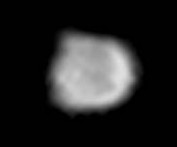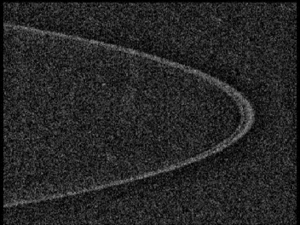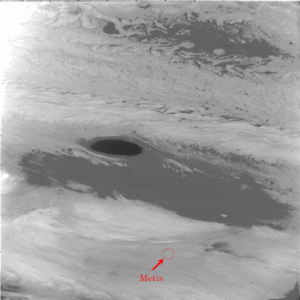Metis (moon) facts for kids

Image taken by Galileo's Solid State Imager between November 1996 and June 1997
|
|
| Discovery | |
|---|---|
| Discovered by | S. Synnott |
| Discovery date | 4 March 1979 |
| Designations | |
|
Named after
|
Μήτις Mētis |
| Adjectives | Metidian, Metidean |
| Orbital characteristics | |
| Periapsis | 127974 km |
| Apoapsis | 128026 km |
|
Mean orbit radius
|
128000 km (1.792 RJ) |
| Eccentricity | 0.0002 |
| 0.294780 d (7 h, 4.5 min) | |
|
Average orbital speed
|
31.501 km/s |
| Inclination | 0.06° (to Jupiter's equator) |
| Satellite of | Jupiter |
| Physical characteristics | |
| Dimensions | 60 × 40 × 34 km |
|
Mean radius
|
21.5±2.0 km |
| ≈ 5800 km2 | |
| Volume | ≈ 42700 km3 |
| synchronous | |
| zero | |
| Albedo | 0.061±0.003 |
| Temperature | ≈ 123 K |

Metis, also known as Jupiter XVI, is the closest known moon to the giant planet Jupiter. It was first spotted in 1979 using pictures from the Voyager 1 spacecraft. In 1983, it was named after Metis, who was the first wife of Zeus in ancient Greek stories.
Later, between 1996 and 2003, the Galileo spacecraft took more detailed pictures. These images helped scientists learn a lot more about Metis's surface.
Metis is "tidally locked" to Jupiter. This means the same side of Metis always faces Jupiter, just like our Moon always shows the same face to Earth. Metis has a very uneven shape, with one side almost twice as long as the shortest side.
It's one of only two moons that orbit Jupiter faster than Jupiter spins! The other is Adrastea. Metis orbits inside Jupiter's main ring. Scientists think it adds a lot of dust and material to these rings.
Contents
Discovering Metis
Metis was found in 1979 by a scientist named Stephen P. Synnott. He saw it in images sent back by the Voyager 1 probe. At first, it was just called S/1979 J 3.
In 1983, it got its official name, Metis. This name comes from a Titaness in Greek mythology. She was the first wife of Zeus, who is like the Greek version of the Roman god Jupiter.
The Voyager 1 pictures only showed Metis as a tiny dot. Because of this, not much was known about it until the Galileo spacecraft arrived. Galileo took pictures of almost Metis's entire surface by 1998. This helped scientists figure out what it might be made of.
The Juno spacecraft reached Jupiter in 2016. It has a camera called JunoCam. While Juno mostly studies Jupiter itself, it might sometimes capture distant images of Metis and Adrastea.
What Metis Looks Like
Metis has a very irregular shape. It measures about 60 kilometers (37 miles) long, 40 km (25 miles) wide, and 34 km (21 miles) thick. This makes it the second smallest of Jupiter's four inner moons.
Scientists don't know exactly how much Metis weighs or what it's made of. However, if it's as light as another moon called Amalthea, it might be made of water ice. This ice would have many small holes, like a sponge.
Metis's surface is covered in many craters from impacts. It looks dark and has a reddish color. One side of Metis, the "leading" side that faces forward as it orbits, is brighter than the "trailing" side. This is probably because the leading side gets hit more often by space rocks. These impacts dig up brighter material, likely ice, from inside the moon.
Metis's Journey Around Jupiter
Metis is the closest of Jupiter's four small inner moons. It orbits Jupiter at a distance of about 128,000 kilometers (79,500 miles). This is inside Jupiter's main ring.
Metis's orbit is almost a perfect circle. It also stays very close to Jupiter's equator. Because Metis is "tidally locked", it spins at the same speed it orbits. This means one rotation takes about 7 hours.
Metis orbits Jupiter faster than Jupiter spins. Because of this, Jupiter's strong gravity slowly pulls Metis closer. If Metis were less solid, Jupiter's gravity might even tear it apart. But because it's solid, it stays together.
Metis is the fastest of all Jupiter's moons. It zips around Jupiter at about 31.5 kilometers (19.6 miles) per second! Jupiter's huge shadow covers all of Metis for about 68 minutes each Metian day.
Metis and Jupiter's Rings

Metis orbits about 1,000 kilometers (620 miles) inside Jupiter's main ring. It actually orbits within a 500-kilometer (310-mile) wide "gap" in the ring. Scientists know this gap is connected to Metis, but they are still figuring out exactly how.
Metis provides a lot of the dust that makes up Jupiter's main ring. This dust likely comes from material that gets knocked off Metis and Jupiter's other three small inner moons by meteorite impacts. It's easy for this material to escape the moons because their surfaces are quite close to the edge of their "Roche spheres." This is the area where Jupiter's gravity is much stronger than the moon's own gravity.
See also
 In Spanish: Metis (satélite) para niños
In Spanish: Metis (satélite) para niños


